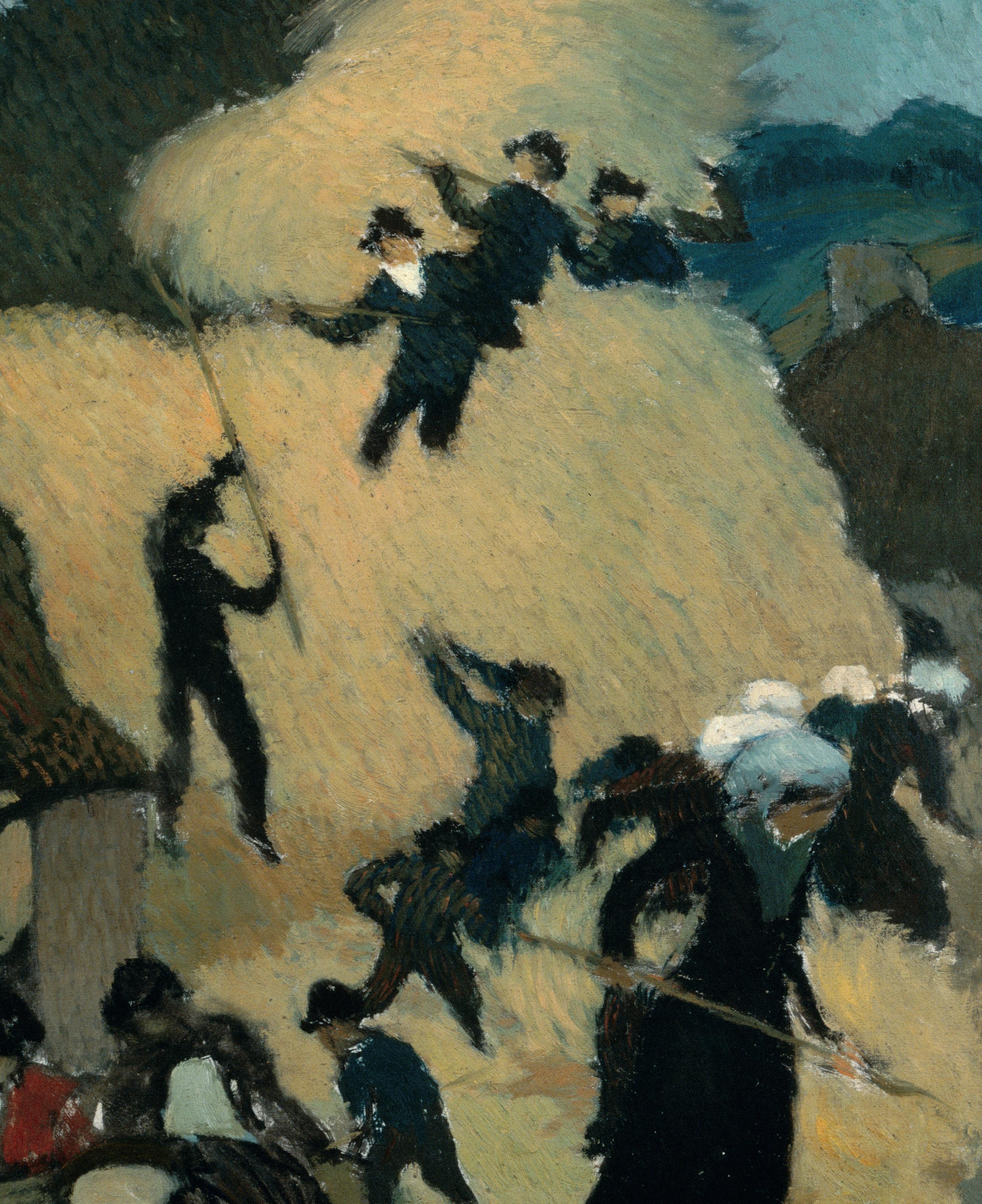
September 2023 1888 1900 Maurice
Denis Early Years
September 2023 1888 1900 Maurice Denis Early Years Brussels 1 rue aux Laines, 1000 Brussels noemie@agnewsgallery.com London 6 St. James’s Place, London, SW1A 1NP anna@agnewsgallery.com www.agnewsgallery.com

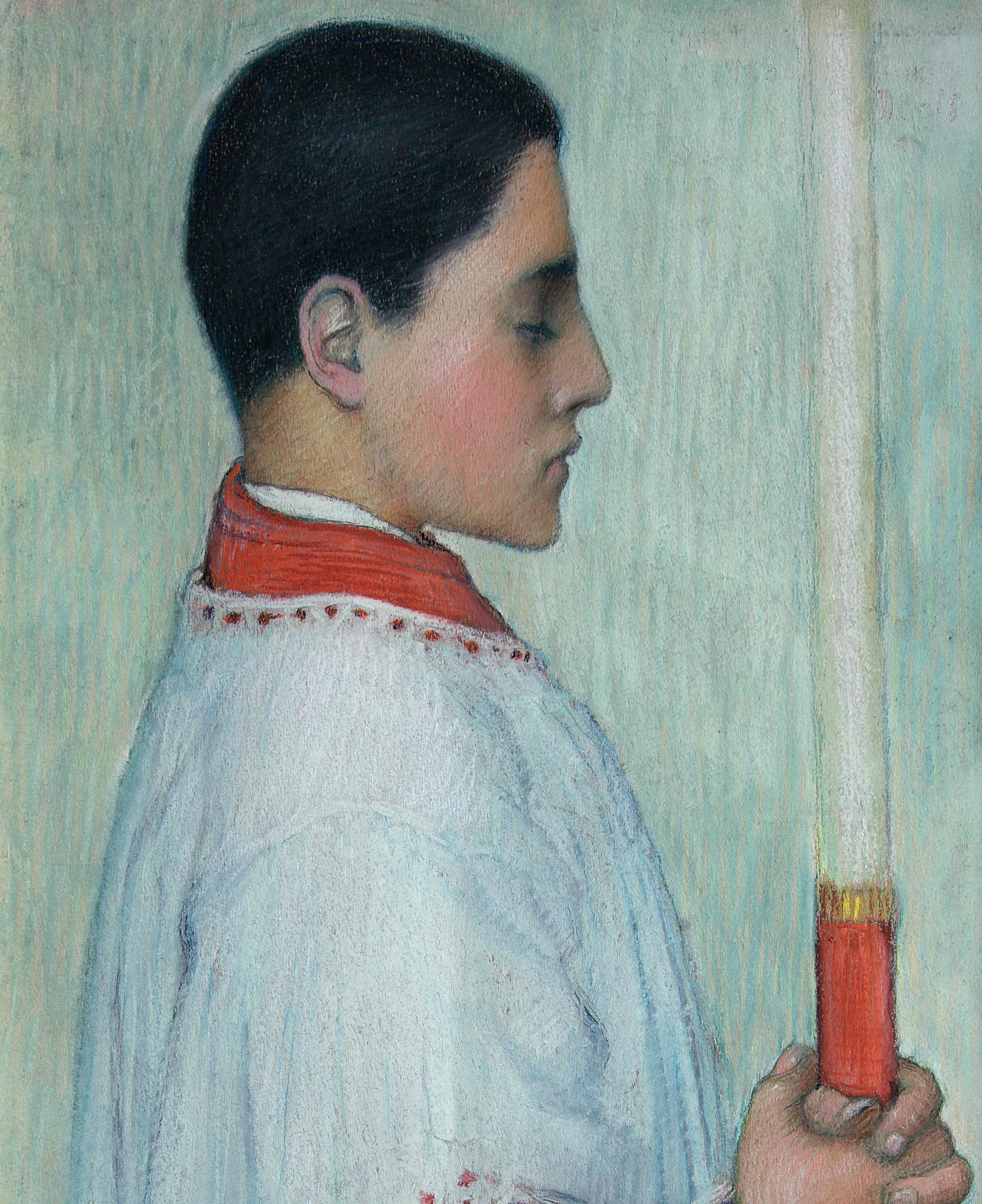
Maurice Denis… what an artist and theoretician! It was only long after completing our Art History studies that we discovered the work of this exceptional artist through his essay on art published in 1890 in Art et Critique 1 magazine. But who was this twentyyear-old artist capable of so clearly theorizing the Nabis movement at the very moment of its birth – thus theorizing symbolism – laying the foundations for neo-traditionalism and the great return of the religious to a brand-new artistic practice? Denis belonged in that category, rather rare in the French tradition of writer-painters. Delacroix, of whom Denis was a fervent admirer, was undoubtedly his most illustrious predecessor in this respect. And yet, Maurice Denis, who had the same talent for writing, produced even more: from 1890 to his death in 1943, he penned nearly two hundred texts, including a dozen books and the Journal posthume
Agnews has always been keen to explore art at its most creative and innovative. True to our word, we present here an exceptional selection of works from Denis’ early years – spanning his late teens to early twenties. Even by the age of fifteen, this young student from a modest background was already writing: “Je ferai de l’Art, de l’Art en masse, en tout et partout. Je me gorgerai, je m’enivrerai de cette pure et sainte jouissance, de cette douce vie, si désirée, d’artiste.”2 (I will make Art, Art in abundance, in everything and everywhere. I will gorge myself, I will get intoxicated with this pure and holy joy, this sweet life, so desired, of an artist.) After arriving in Paris, Denis met Édouard Vuillard and Paul Sérusier at the Académie Julian in 1888; soon they shared a desire to break away from academic art. Sérusier gave Denis the famous Le Talisman (Musée d’Orsay, Paris), which he kept like a relic for the rest of his life. The greatest lesson Denis learned from this canvas was the use of colour. Here, we have compiled a surprisingly rare selection teeming with all the freshness and spontaneity of youth. The strong influence of the Nabis aesthetic is palpable, most notably the desire to abolish the boundary separating decorative arts from traditional painting – far from what could be considered superficial Impressionism. Denis would later write: “La première période de ma peinture, c’est l’amour, l’émerveillement devant la beauté de la femme et de l’enfant.”3 (The first period of my painting is love, the wonder in the beauty of the woman and the child.) We can feel this sentiment, too. Also note a certain form of musicality that’s omnipresent in his work – in the materials, look, colours, and attitudes.
By the time he was twenty, Denis was already an artist eager to include his Christian faith in his art: “Il faut tenter un effort, un grand effort pour ramener l’Art à son grand Maitre qu’est Dieu : pour le courber de nouveau au service de Celui qui peut seul inspirer les grandes choses.”4 (One must make an effort, a great effort, to bring Art back to its great Master who is God: to bend it again to the service of the One who alone can inspire great things.) At the time, he seemed to be the only member of the Parisian avant-garde to attempt this endeavour. For the Nabis, the spiritual was everywhere and much more than in God; for Denis, a great admirer of Fra Angelico, the spiritual was first and foremost in God. In 1896 he wrote: “Tout chef d’œuvre est symboliste. Or le symbolisme est une théorie chrétienne.”5 (Every masterpiece is symbolic. Yet symbolism is a Christian theory.) Deus sive Natura. For a long time, we thought the religious element took on full meaning in Denis’ art only from 1897-98 onwards. But we were wrong. It is on full display even from his earliest works – with the artist’s distinctive blend of determination, exploration and subtlety.
What an immense pleasure to contemplate Maurice Denis’ art in this way.
Eric Gillis & Noémie Goldman
1. Pierre-Louis (pseudonym), “Définition du néo-traditionnisme”, in Art et Critique, 23 and 30 August 1890.
2. Maurice Denis, Journal , Volume I (1884-1904), p. 34 (30 July 1885).
3. Maurice Denis, Journal , Volume III (1921-1943), p. 214 (31 December 1939).
4. Maurice Denis, Journal , Volume I (1884-1904), p. 64 (5 January 1886).
5. Maurice Denis, “Notes sur le peinture religieuse”, in L’Art et la Vie, Issue 54, October 1896.
PAINTINGS
1 Maurice Denis 1870 Granville – Saint-Germain-en-Laye 1943 Nu aux cheveux noirs
Oil on canvas, 1889
Monogram of the artist’s studio lower left
Canvas 56,5 x 46 cm
Provenance The artist’s studio, Saint-Germain-en-Laye; his son, Dominque Denis, Saint-Germain-en-Laye; thence by descent, France
In his first diary, Maurice Denis thus explains his personal vision for depicting the human body. In the present painting, the artist takes part in the long tradition of the academic nude, but his technique reveals the evolution of his artistic research. The space is materialised by geometric shapes that structure the composition, and this background is treated in flat tones of grey, contrasting the woman’s body and giving it a sculptural presence. The intense black of her hair and sex responds to the black square evoking a piece of furniture in front of which she poses. The body is not smooth, but vibrates with light. This quality Denis has achieved by using visible hatching brushstrokes which almost obscure her form, as if the artist was trying to preserve the mystery of (and his respect for) the woman’s body, thus mixing sensuality and spirituality. The painting’s frontal and explicit nudity recalls to that of La Dame au Jardin clos (Musée d’Orsay, Paris) made later, in 1894, which represents the artist’s wife, Marthe. In these two works Denis succeeded in translating all the carnal beauty of the female body, which is also found in nudes seen from the back, as for instance Nu, femme assise de dos of 1891 (Musée d’Orsay, Paris), and Nu au crepuscule (Private collection), ca. 1892.
Maurice Denis’ artistic apprenticeship began in drawing from plaster models in the studio of the artist Jules Balla in 1885. When he entered the Académie
Julian and then the École des Beaux-Arts in 1888, he drew from live models. Examples from this period include works such as Étude de nu: femme debout de dos, and Étude de nu: femme debout de face, both at the Musée Maurice Denis, Saint-Germain-en-Laye. For the young artist, these studies then led to the present Nu aux cheveux noirs, which is charged with a new pictorial energy and marks a pivotal moment in the artist’s career. It testifies to Denis’ emancipation from academic art and the increasing influence of Paul Gauguin’s Synthesist example.
This sincere and respectful tribute to the female anatomy, presented unambiguously at its most beautiful, echoes Odilon Redon’s vision for the female body, which Redon described in 1888: “[…] a nudity that reassures us, because it does not hide it; it leaves it thus, without shame, in an Eden, for glances that are not ours, but those of a cerebral world, an imaginary world created by the painter, where beauty moves and spreads, which never engenders shamelessness, but on the contrary, defers to all nudity a pure appeal that does not lower us.”2
Claire Denis and Fabienne Stahl have added the present work to the catalogue raisonné in preparation, under the number 889.0030.
6
We must not give up the idea of reconciling what we call the flesh with what we call the spirit, this reconciliation is the object of our essential effort 1
1. Thérèse Barruel, Guy Cogeval, et al., Maurice Denis 1870-1943, Lyon, 1994, p. 193.
2. Odilon Redon, À Soi-même, Paris, 1961, p. 94 (14 May 1888).
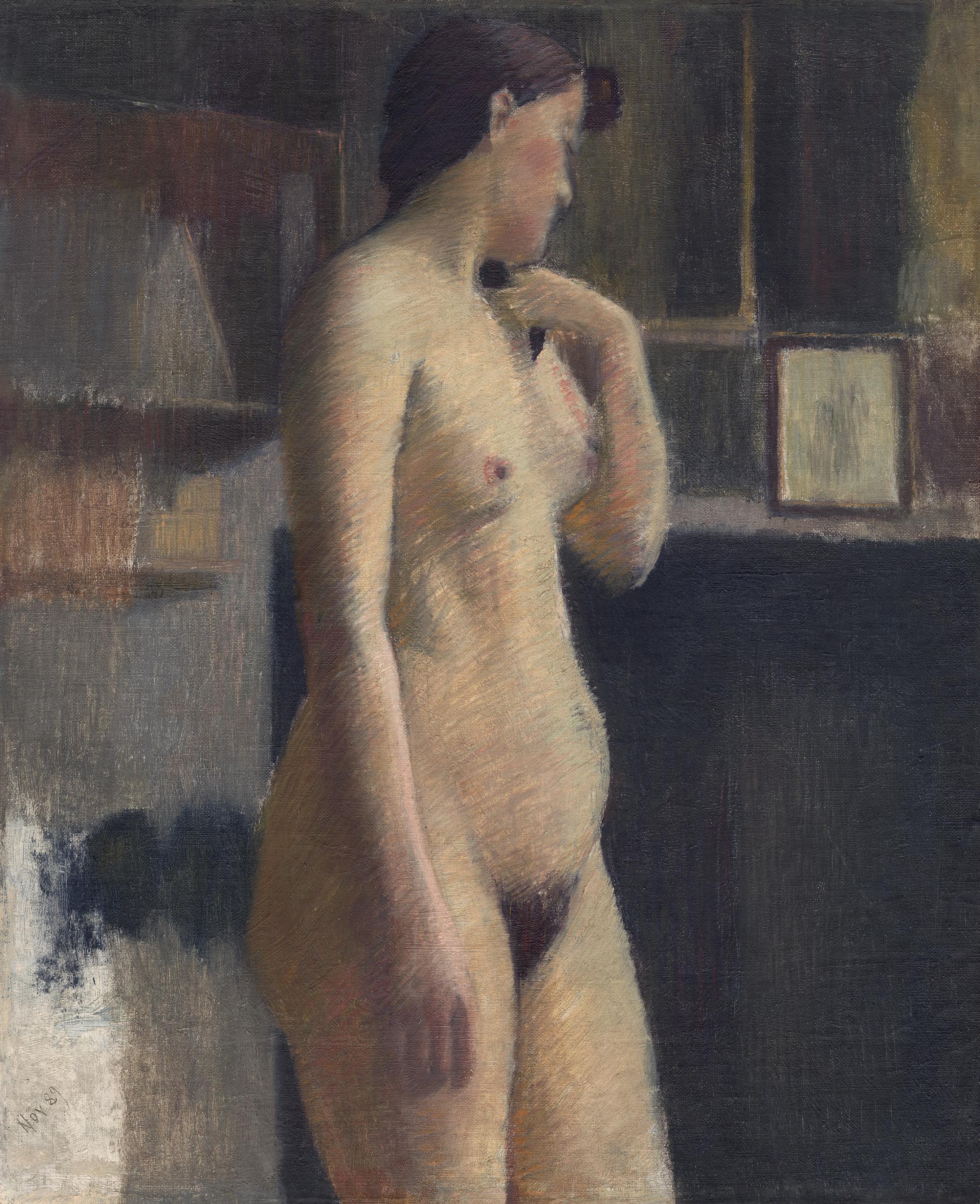
7
2 Maurice Denis 1870 Granville – Saint-Germain-en-Laye 1943
Autel jaune
Oil on canvas, ca. 1889-1890
Vertical monogram upper left MAVD, dated lower right Hiv.89.9
Canvas 27 x 20,5 cm
Literature Fabienne Stahl, Décors religieux Beautés du Ciel de Maurice Denis au Vésinet 1898-1903, Saint-Germain-enLaye, 2014, p. 10 (ill.); Fabienne Stahl, Maurice Denis Bonheur Rêvé, Paris, 2021, p. 34 (ill.)
Exhibition Saint-Germain-en-Laye, Musée départemental Maurice Denis, Maurice Denis Bonheur Rêvé, 18 Sept. 2021-19 June 2022, no. 7, p. 34
Provenance The artist’s studio, Saint-Germain-en-Laye; his son, Dominque Denis, Saint-Germain-en-Laye; thence by descent, France
Yes, I must be a Christian painter, I must celebrate all the miracles of Christianity. 1
This is how Maurice Denis described his faith and his early attraction to art in 1885. In creating this painting, the artist was directly inspired by a religious service in the chapel of the Virgin in the church of Saint-Germain-en-Laye, and he sought to represent God without recourse to realism or traditional means of depiction. Through form, line, and colour, Denis suggests the presence of divine light during the celebration of the mass, particularly as it is manifest in the bright yellow of the altar. The aesthetics of the liturgy and parish life were a continual source of inspiration for Denis, as shown in early works such as La Prière au livre jaune (ca. 1889, Private collection), or Le Christ vert and La Messe (both 1890, Musée d’Orsay, Paris). These works underscore the artist’s dual religious and artistic vocation—as he himself said, “It is there that my artist’s soul and my Christian heart are founded.”2 The painting’s bright palette, which helps to express this Christian fervour and spiritual miracles, is accentuated by its flat treatment of the paint. Its forms, stripped of nearly all detail, are inspired by the Synthetism developed by Paul Gauguin, and they articulate Denis’ own desire to use the plastic means of painting to express the essentials of an idea. In this work, that vision is applied precisely, and it communicates the inseparable link between religious
creation and the aesthetic inventiveness, as Gauguin evoked in in an 1888 letter to Schuffenecker: “Art is an abstraction; draw it from nature by dreaming in front of it and think more of the creation than of the result, it is the only way to ascend to God by doing as our Divine Master did, to create.”3
Through his inspirations and artistic experiments, Denis was able to inaugurate a renewal of sacred art, just as the painters of the Nazarene movement, who wished to revitalise art through the spiritual and moral values of Christianity, did at the beginning of the 19th century. But Denis’ own genius is distinguished by his modernisation of Christian iconography and his personal faith, as Jan Verkade described it in 1891: “there were several religious pictures among his paintings which almost exclusively glorified this happy piety […]. I felt instinctively what enrichment faith had brought to this young artist who had grown up a devout Catholic.”4
Claire Denis and Fabienne Stahl have added the present work to the catalogue raisonné in preparation, under the number 889.0049.
Bouillon, Maurice Denis, Genève, 1993, p. 9.
2. Fabienne Stahl, Maurice Denis Bonheur Rêvé, Paris, 2021, p. 26.
3. Jean-Paul Bouillon, Maurice Denis, Genève, 1993, p. 19.
4. Fabienne Stahl, Beautés du Ciel de Maurice Denis au Vésinet 1898-1903, Saint-Germain-en-Laye, 2014, p. 19.
8
1. Quoted in Jean-Paul
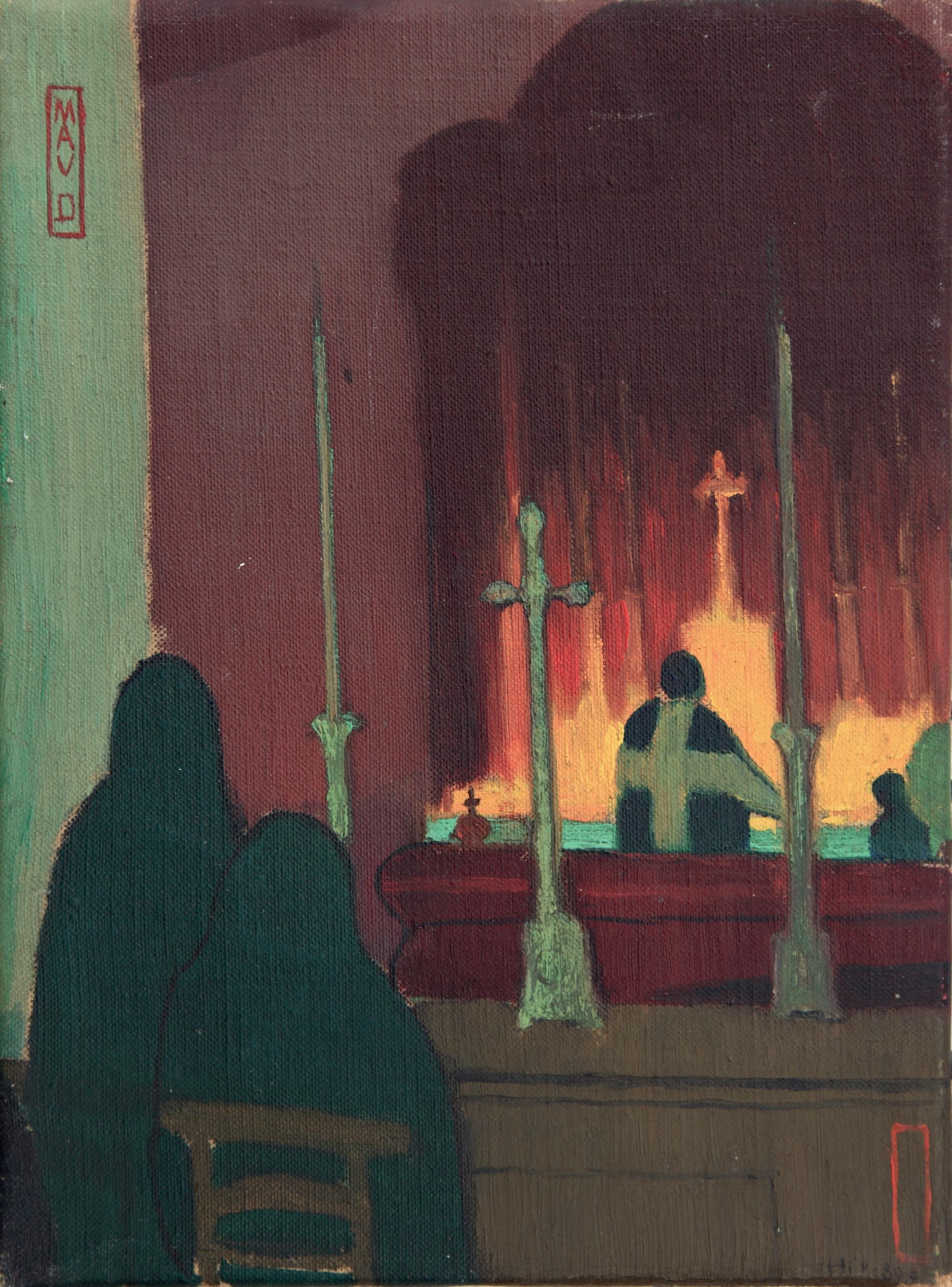
9
3 Maurice Denis 1870 Granville – Saint-Germain-en-Laye 1943
Le Regard
Oil on canvas, ca. 1890
Monogram of the artist’s studio lower left
Canvas 24 x 20 cm
Provenance The artist’s studio, Saint-Germain-en-Laye; his son, Dominque Denis,
In this exceptional early portrait, Maurice Denis demonstrates his talent in capturing facial expression. Framing the portrait tightly on the small canvas, Denis fixes his attention on this woman’s head, seen in profile, her hair tied up in a bun. By presenting this view up close, the artist evokes a mysterious emotional narrative for the woman, inviting different interpretations and asking the viewer to guess what the woman might be gazing at. The background is rendered in wide bands of colour, and the dark blue to the right suggests a nocturnal setting. That blue is echoed in the delicate chiaroscuro of the woman’s shadowed visage, silhouetted against an artificial yellow light that seems to absorb the woman’s attention. This strong and sensitive contrast of light and dark suggests a kind of double vision, a dualism that exalts powerful feeling within an atmosphere of mystery. The face raised to the sky suggests that the woman may be praying, and the artist ably transcribes this intimate moment of pious devotion in the presence of divine light.
Starting in his adolescence, Maurice Denis was fascinated by the paintings of the Italian Primitives, whose works he studied at the Louvre. For a time, he considered becoming an artist monk in the tradition of Fra Angelico, which testifies as much to his faith as to his interest in art. The use of yellow and blue in this profile is reminiscent of the colours used by the Quattrocento Florentine painter, notably his Annunciation of 1426 (Prado Museum, Madrid), which depicts the Virgin
Mary draped in a blue cloak in front of the archangel Gabriel, illuminated by a shaft of golden-hued light: the presence of God. Denis depicted similar moments of religious exaltation throughout his career, as in the lithograph titled Love: And It Was a Religious Mystery of 1890, from the series Les Amours de Marthe, which combines Denis’ love of God with his love of woman. Denis’ use of a face seen in profile, highlighting a moment of deep prayer and intense spirituality, are also found in Denis’ La Visitation of 1894 (Hermitage, Saint Petersburg), the composition of which was recycled by Denis for his Magnificat of 1909 (Private collection), as well as his Miracle of 1897 (Musée Maurice Denis, Saint-Germain-en-Laye).
This spiritually and emotionally intense profile, of a gaze turned towards faith, is the aesthetic embodiment of Maurice Denis’ own stated belief in God and art: “Painters only speak of God in terms of beauty, whiteness and harmonious logic. When the Word is silent […], the spectacle of images still tells us and teaches us the truth of God’s acts.”1
Claire Denis and Fabienne Stahl have added the present work to the catalogue raisonné in preparation, under the number 890.0048.
10
1. Fabienne Stahl, Beautés du Ciel de Maurice Denis au Vésinet 1898-1903, Saint-Germain-en-Laye, 2014, p. 9.
Saint-Germain-en-Laye; thence by descent, France
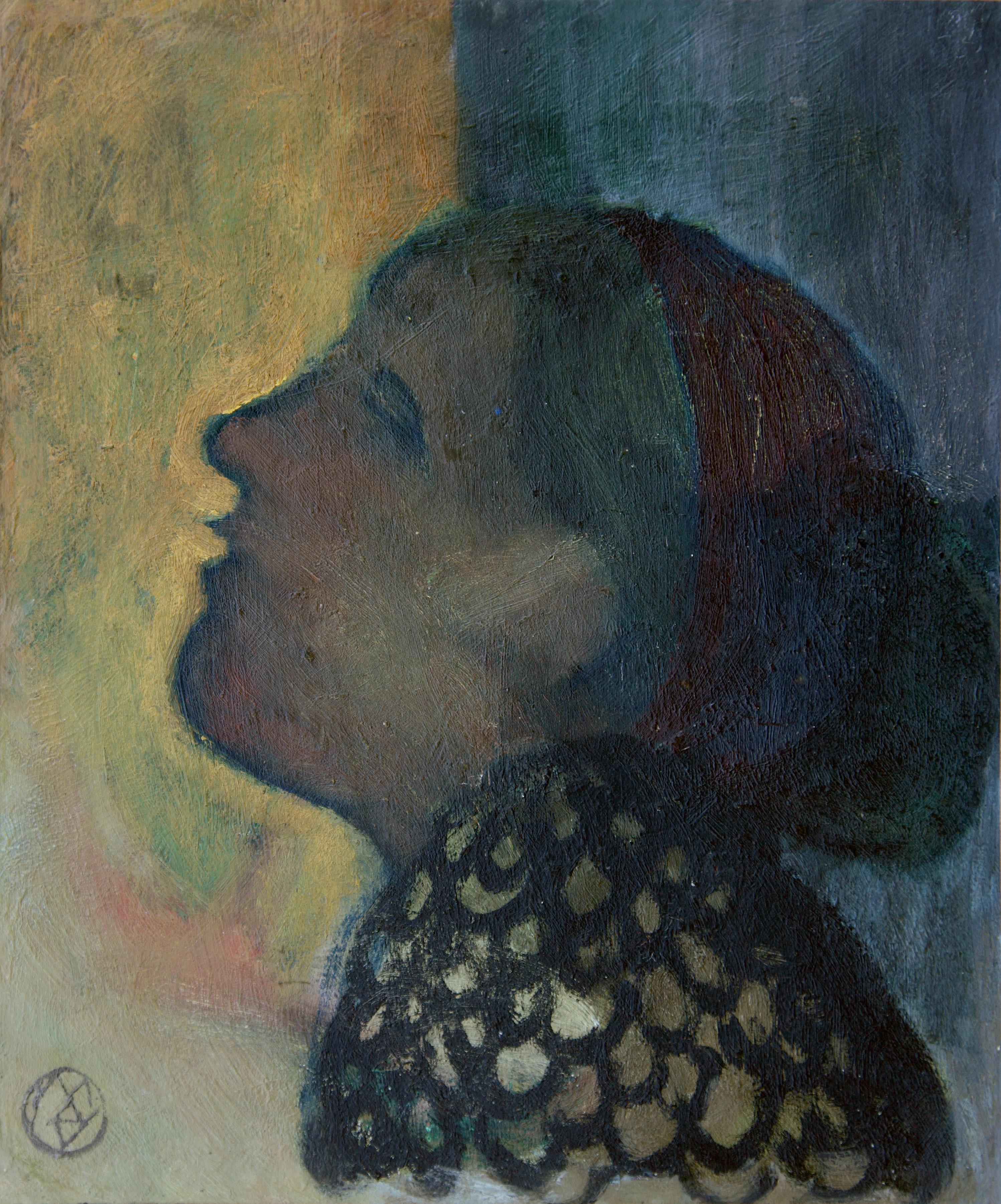
11
4 Maurice Denis 1870 Granville – Saint-Germain-en-Laye 1943
La Meule de paille
Oil on canvas, ca. 1891
Canvas 41 x 33 cm
Literature Thérèse Barruel, Guy Cogeval, et al. Maurice Denis 1870-1943, Lyon, 1994, no. 55 (ill.)
Exhibition Lyon, Musée des Beaux-Arts, Maurice Denis 1870-1943, 29 septembre – 18 décembre 1994, no. 55, p. 181 (ill.)
Saint-Germain-en-Laye, Musée départemental Maurice Denis, Maurice Denis et la Bretagne, 18 Oct. 2011 – 22 Jan. 2012, no. 8
Provenance The artist’s studio, Saint-Germain-en-Laye; his son, Dominque Denis, Saint-Germain-en-Laye; thence by descent, France
Most of the houses are still thatched and built with cob, earth and straw. But civilisation has imported tiles and plaster. So much the worse. […] The women have a white cap that covers their head completely, short dresses, dark clothes; the men wear a blue blouse, a felt hat, sometimes silk.1
Maurice Denis describes the commune of Pré-en-Pail in his diary, and this work reproduces some of its details, such as the women wearing white caps and the dark clothes of the peasants. In this important work, Denis turns away from traditional perspective and instead relies on the different proportions of individual figures to suggest depth. Denis’ distribution of these figures and the straight lines of their pitchforks structures the space and gives the scene a feeling of movement and dynamism. The triangular shape of the straw mound underscores the height of the task to be accomplished by the peasants, whose black clothes contrast with its illuminated yellow colour. Nevertheless, Denis’ hatched paint strokes, and his decision not to clearly define the figures’ contours, cause the bright straw to seemingly merge with those dark clothes, resulting in a vibrating and lively composition.
Although he lived in Saint-Germain-en-Laye for most of his life, Denis spent many of his childhood holidays in his native Normandy, near Alençon, on his grandparents’ farm, which inspired many of his works. This direct confrontation with an idyllic pastoral countryside was for him a real aesthetic shock. The country was an inexhaustible source of artistic inspiration for Denis, provoking an emotional
response as well as idealised visions of the landscape and of the peasants’ daily life. Brittany became a favourite subject throughout his career, and this straw pile communicates a sense of organic cooperation between nature and man, achieved through humble daily work. The life and customs of the Breton people are also portrayed in Denis’ Femmes bretonnes of 1890 (Musée d’Orsay, Paris), La Danse bretonne of 1891, and La femme et la vache, ca. 1893 (Indianapolis Museum of Art).
The present painting is nearly a tribute to Paul Gauguin, an artist Denis admired very much. The pastoral works of both Gauguin and Sérusier actually strengthened Denis’ own attachment to Brittany. Denis remained faithful to the example that Gauguin set in Pont-Aven long after the creation of the Nabis group, as evidenced by the large and flat expanses of yellow which economically express this pile of straw in its bare essence. Denis’ love for Brittany was marked by his honeymoon in the region with Marthe in 1893, and by his 1908 purchase of the villa Silencio in PerrosGuirec, in front of which the artist’s words, engraved on a plaque, still resonate: “Never has nature seemed more beautiful to me than in Perros.”
Claire Denis and Fabienne Stahl have added the present work to the catalogue raisonné in preparation, under the number 891.0032.
12
1. Quoted in Thérèse Barruel, Guy Cogeval, et al., Maurice Denis 1870-1943, Lyon, 1994, p. 181.
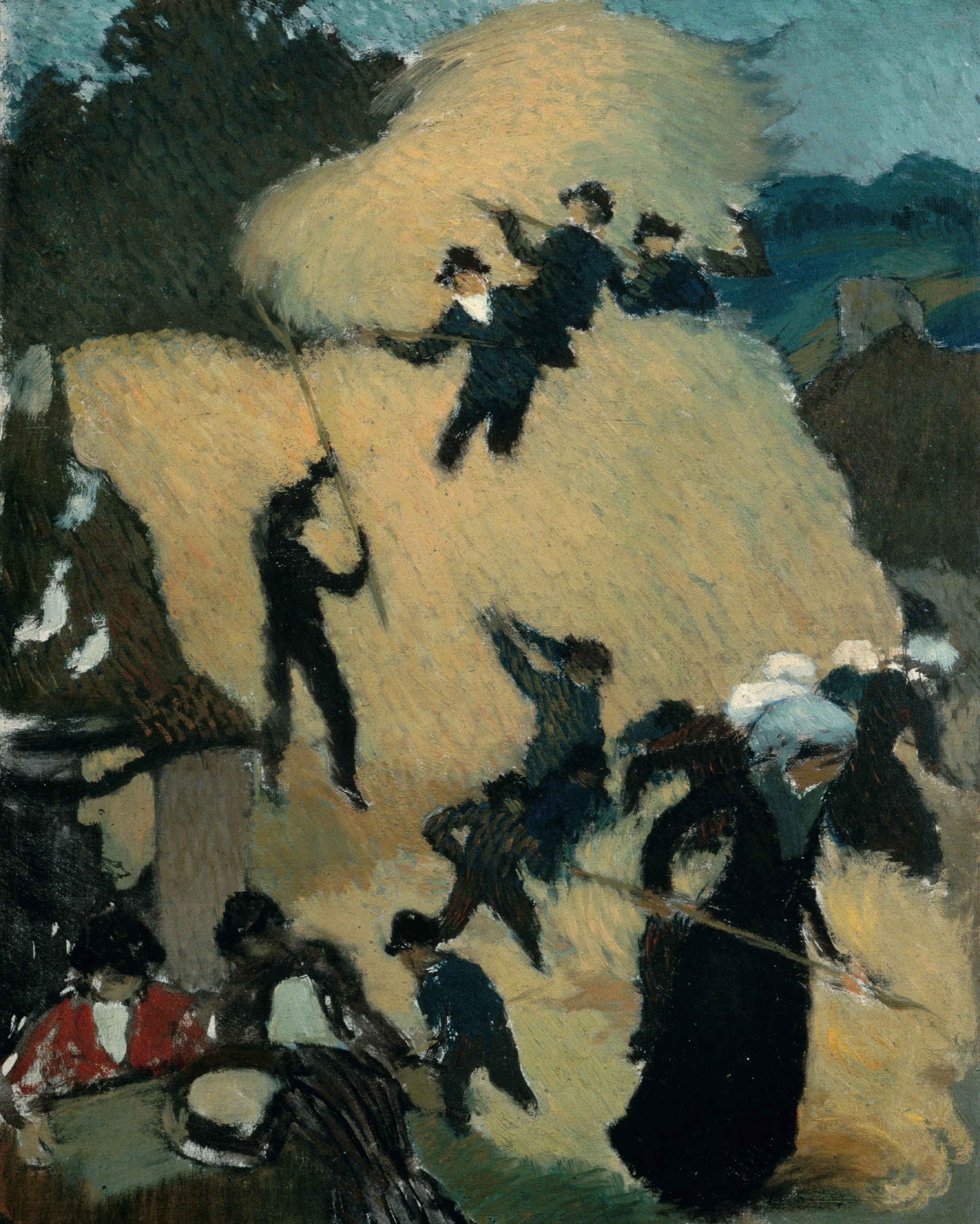
13
DRAWINGS
I will make art, in everything and everywhere. I will gorge myself, intoxicate myself with this pure and holy enjoyment, with this sweet life, so desired, of an artist, Maurice Denis, 30 July 1885 when he was fifteen years old (quoted in Fabienne Stahl, Maurice Denis Bonheur Rêvé, Paris, 2021, p. 23).
Maurice Denis kept multiple diaries from 1884 until the end of his life. These books reveal a deep passion for art that began in Denis’ adolescence, as well as an early determination to make it his profession. As an only child and a dreamer, Denis started visiting the municipal museum of Saint-Germain-en-Laye at the age of eight, which sparked a developing artistic curiosity in the boy. He began an official apprenticeship in drawing at the Lycée Condorcet in 1882, and despite his parents’ reluctance to see him follow an artistic path, his father authorised him to take drawing lessons in 1884 with the artist photographer Jean-Dominique Zani. The following year he studied in the studio of Jules Balla, and in 1888 he entered the Académie Julian and then the École des Beaux-Arts in Paris. Denis drew daily and in different media, looking at everything as a possible subject for composition, seeking to retain only its essential character. These intimate drawings are the products of an artist who seeks to capture the reality of vision, the snapshot of an image that fixes his emotion on the page. This selection of works thus reveals Denis’ creative process and his various artistic inspirations as he commenced his search for a new, singular form of art, one that embodies the three-part formula of Art, Love, and Faith
Claire Denis and Fabienne Stahl have added the present works to the catalogue raisonné in preparation, under the numbers D1406, 889.1008, D1444, D1432, 891.0056, D0059, 896.1026, D1239, 898.0045, D1423, D1416.
5 Femmes à la Sainte Table
Charcoal and chalk on wove paper, 1888
Dated lower right Nov.1888
Sheet 230 x 160 mm
Exhibition Lyon, Musée des Beaux-Arts, Maurice Denis 1870-1943, 29 Sept.-18 Dec. 1994, no. 55, p. 181 (ill.)
Provenance The artist’s studio, Saint-Germain-en-Laye; his son, Dominque Denis, Saint-Germain-en-Laye; thence by descent, France
Maurice Denis was brought up by a fervent Catholic mother and attended church services in SaintGermain-en-Laye from childhood. The texts of the Catholic Church, as well as its religious songs, liturgy, ceremonies, and the procession of the faithful, provoked not only his religious faith, but also his first aesthetic emotions. For a while, Denis considered becoming an artist monk, like the Florentine painter Fra Angelico. In 1884 he wrote in his diary “I swear to be always faithful to the Christian religion”1, and his talents were first expressed in the drawing of religious images, contemporary scenes, and coloured sketches for larger compositions. Three of the present works are
just such drawings, including Femmes à la Sainte table. In this charcoal work with chalk highlights, the artist has successfully wielded the nuances of his chosen media, translating a diffusion of light that emanates from the candle held by the altar boy. Denis would eventually use this composition to illustrate an edition of the Imitation of Jesus Christ by Thomas à Kempis, for which he produced two hundred and sixteen original wood engravings, published by Ambroise Vollard in 1903.
16
1. Jean-Paul Bouillon, Maurice Denis, Genève, 1993, p. 9.
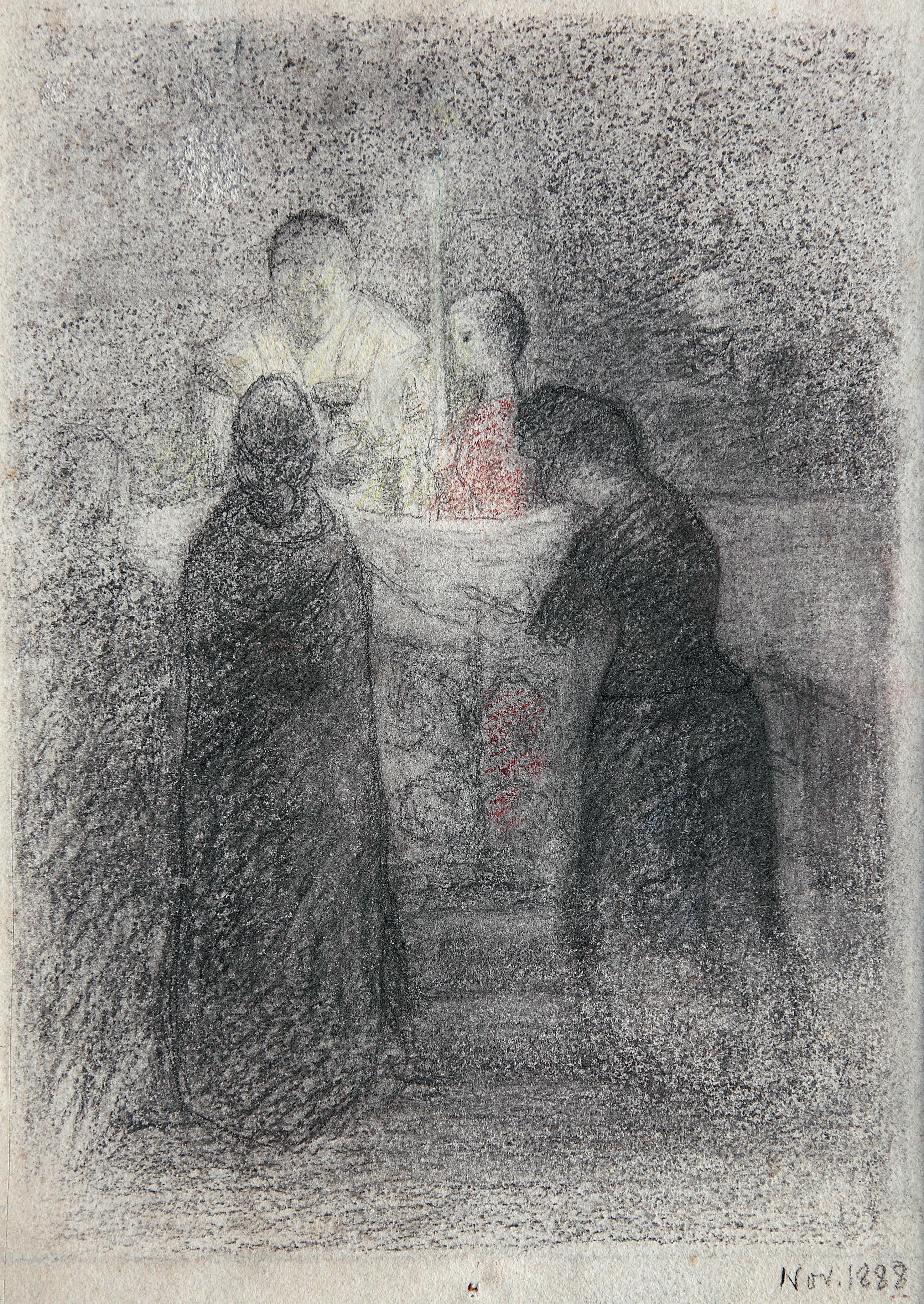
17
6 Messe Matinale
Pastel on wove paper, 1889
Vertical monogram lower left MAVD
Sheet 326 x 251 mm
Exhibition Lyon, Musée des Beaux-Arts, Maurice Denis 1870-1943, 29 septembre – 18 décembre 1994, no. 194, p. 320 (ill.)
Provenance The artist’s studio, Saint-Germain-en-Laye; his son, Dominque Denis, Saint-Germain-en-Laye; thence by descent, France
In the stunning pastel Messe Matinale, Denis again depicts religious ritual, this time the Holy Communion with Christ. For Denis, the moment provoked a true aesthetic emotion, one that he communicates with bright flat colours which structure the composition.
His use of pure, radiant yellow for the altar and the candelabras suggests the light of the divine presence, as it does in the work La Messe of 1890 (Private collection).
18
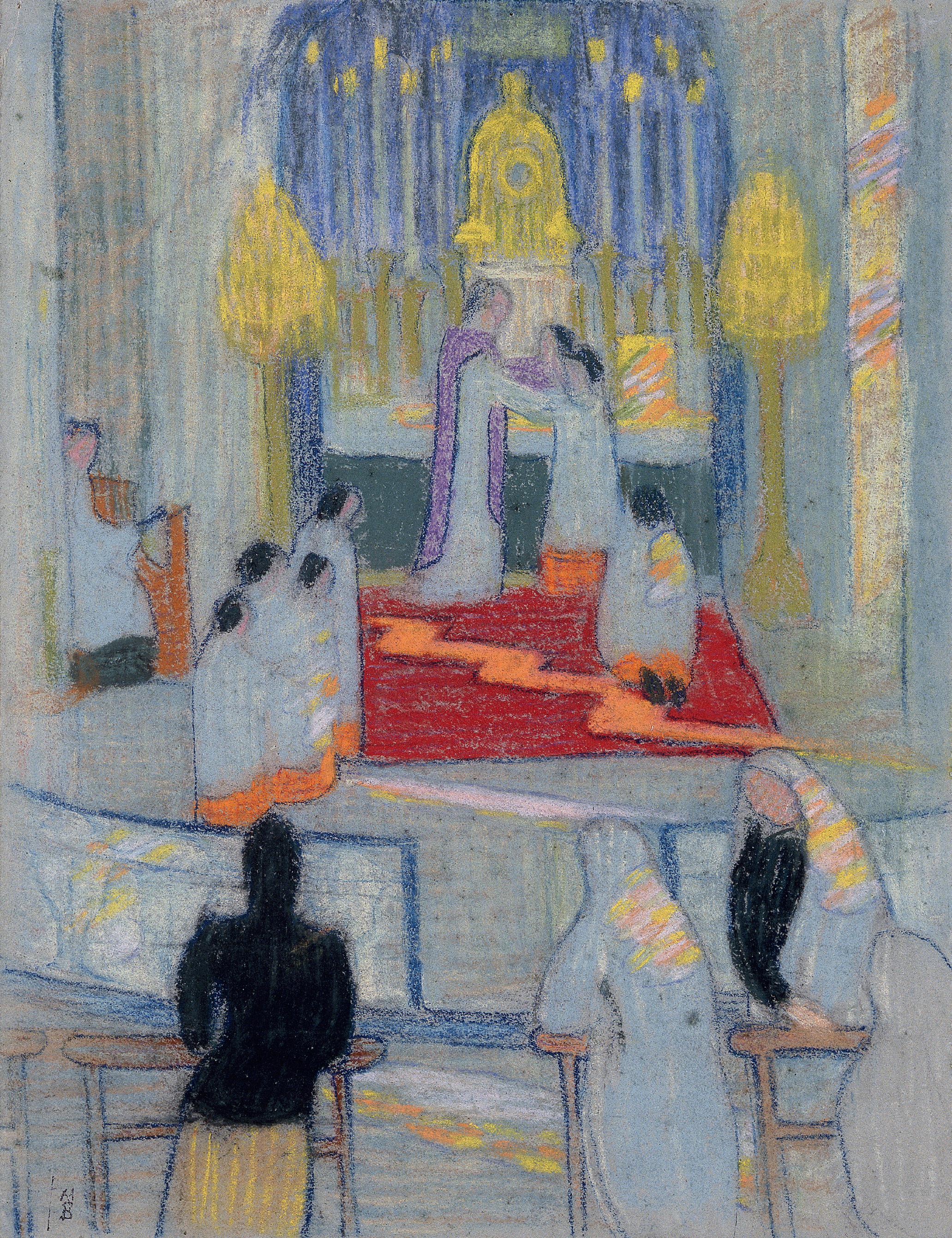
19
Pastel and black pencil on wove paper, ca. 1889-1890
Sheet 680 x 290 mm
Exhibition Paris, Salon de la Société des artistes français, May 1890
Lyon, Musée des Beaux-Arts, Maurice Denis 1870-1943, 29 Sept.-18 Dec. 1994, no. 194, p. 320 (ill.)
Provenance The artist’s studio, Saint-Germain-en-Laye; his son, Dominque Denis, Saint-Germain-en-Laye; thence by descent, France
The theme of the altar boy recurs frequently in Denis’ work. The exceptional pastel L’Enfant de chœur marks a turning point in his artistic life, as it is the very first work he exhibited at the Palais des Champs Elysées, during the 108th Salon de la Société des artistes français in May 1890. This meticulous drawing shows a perfect mastery of pastel, which Denis uses to render a play of delicate shadows and the delicacy of white lace over the boy’s bright red alb. The child’s face, with closed eyes and a hieratic posture, contributes to the solemn character of the picture. This pastel is a preparatory sketch for the work Mystère Catholique, begun in 1889, for which Denis produced five versions until 1891. In that larger composition, the artist depicts an Annunciation but replaces the Archangel Gabriel with a deacon and two altar boys. The poet Adolphe Retté
testified in 1891 to the evocative power of the work: “A religious feeling that is almost painful because of its intensity.”1
On the reverse side of L’Enfant de chœur, Denis has drawn a female nude. Together, these two works underscore Denis’ profusion of different ideas, which are often expressed through the same medium. This perfect academic nude, certainly done during his studies of the live model at the Académie Julian, shows the artist’s talent and his acute ability to observe minute detail and to capture accurate contours.
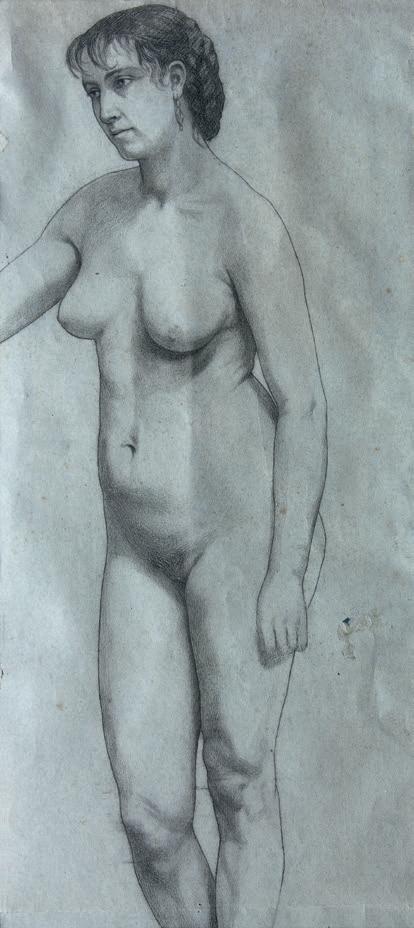
20
1. Adolphe Retté, “Maurice Denis”, in La Plume, 1er Sept. 1891, p. 301.
7 L’Enfant de chœur Étude de nu : Femme debout de face (verso)
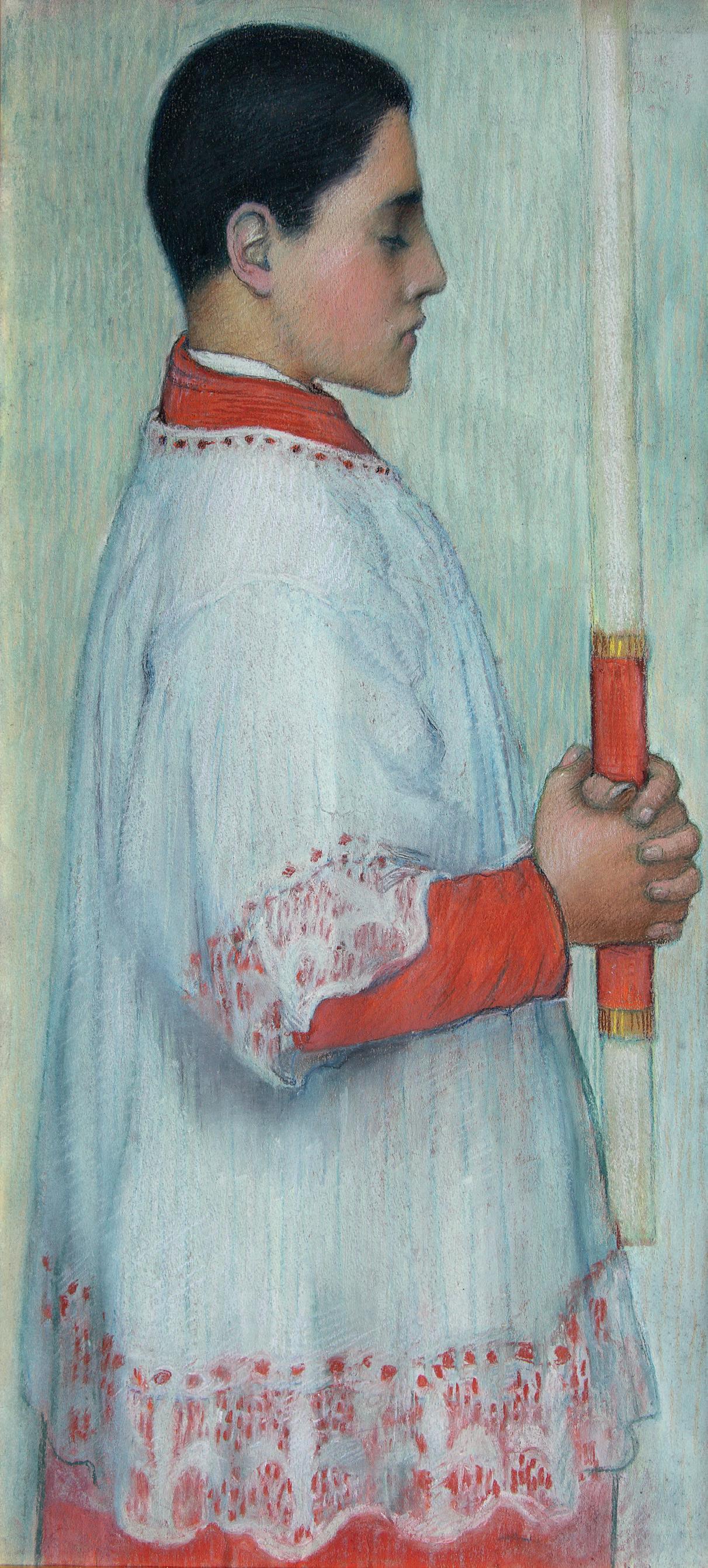
21
8 Femme coiffant un enfant
Pastel on wove paper, 1889
Vertical monogram lower left MAVD Sheet 250 x 84 mm
Provenance The artist’s studio, Saint-Germain-en-Laye; his son, Dominque Denis, Saint-Germain-en-Laye; thence by descent, France
That a single artwork might move freely between sacred and profane subjects, between the love of God and that of women and children, is confirmed by the pastel Femme coiffant un enfant. In this composition, the artist models each form and defines the contours of its silhouettes entirely through colour. The apparent speed of its execution sits in counterpoint to the obvious
care Denis has given to each element, allowing him instantly to capture the scene and the gestures of his models, such as the crossed arms of the sitting little girl. The red background reinforces the scene’s warm and intimate atmosphere. Its anecdotal character is similar to the work Essayage, circa 1903, Private collection.
22
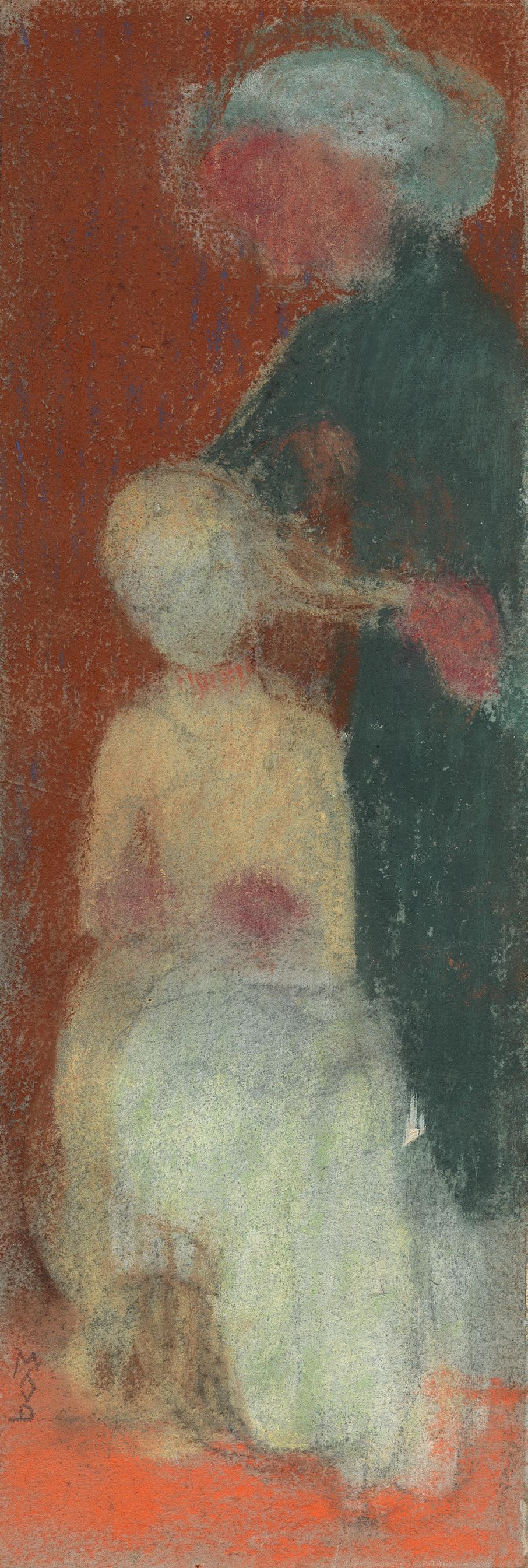
23
9 Portrait de femme de profil
Oil on cardboard, ca. 1891
Size 239 x 205 mm
Provenance The artist’s studio,
In the early 1890’s, Maurice Denis experimented with different techniques and became interested in neo-impressionism. He was aware of and interested in the pointillist divisionism of Georges Seurat, some of whose works he had seen at the Salon des Indépendant s. As Denis himself testified, “Seurat was the first to try to replace the more or less fanciful improvisation from nature with a method of thoughtful work. He sought to put things in order, to create the new doctrine that everyone was waiting for.”1 The Portrait de femme de profil evokes Denis’ admiration for Seurat and his search to reconcile divisionism with the Synthetism of Paul Gauguin. Framing this portrait, Denis has cut a tight window of dotted marks out of a plain pinkish background, which accentuates the face’s contours
and seems to present it in front of a sky glittering with stars. This personal pointillism harmonises with the pointillist colours which Denis has used to illuminate this blue-eyed profile, whose model is probably Marthe, whom Denis met in 1890 and married in 1893. But moreover, this small oil is an exceptional example of Denis’ Nabis period, and of Nabis art more generally. The technique and subject matter of this oil on cardboard are similar to that found in Jeunes filles à la lampe of 1891 (Private Collection), which depicts Marthe and her sister Eva.
24
1. Thérèse Barruel, Guy Cogeval, et al., Maurice Denis 1870-1943, Lyon, 1994, no. 154, p. 116.
Saint-Germain-en-Laye; his son, Dominque Denis, Saint-Germain-en-Laye; thence by descent, France
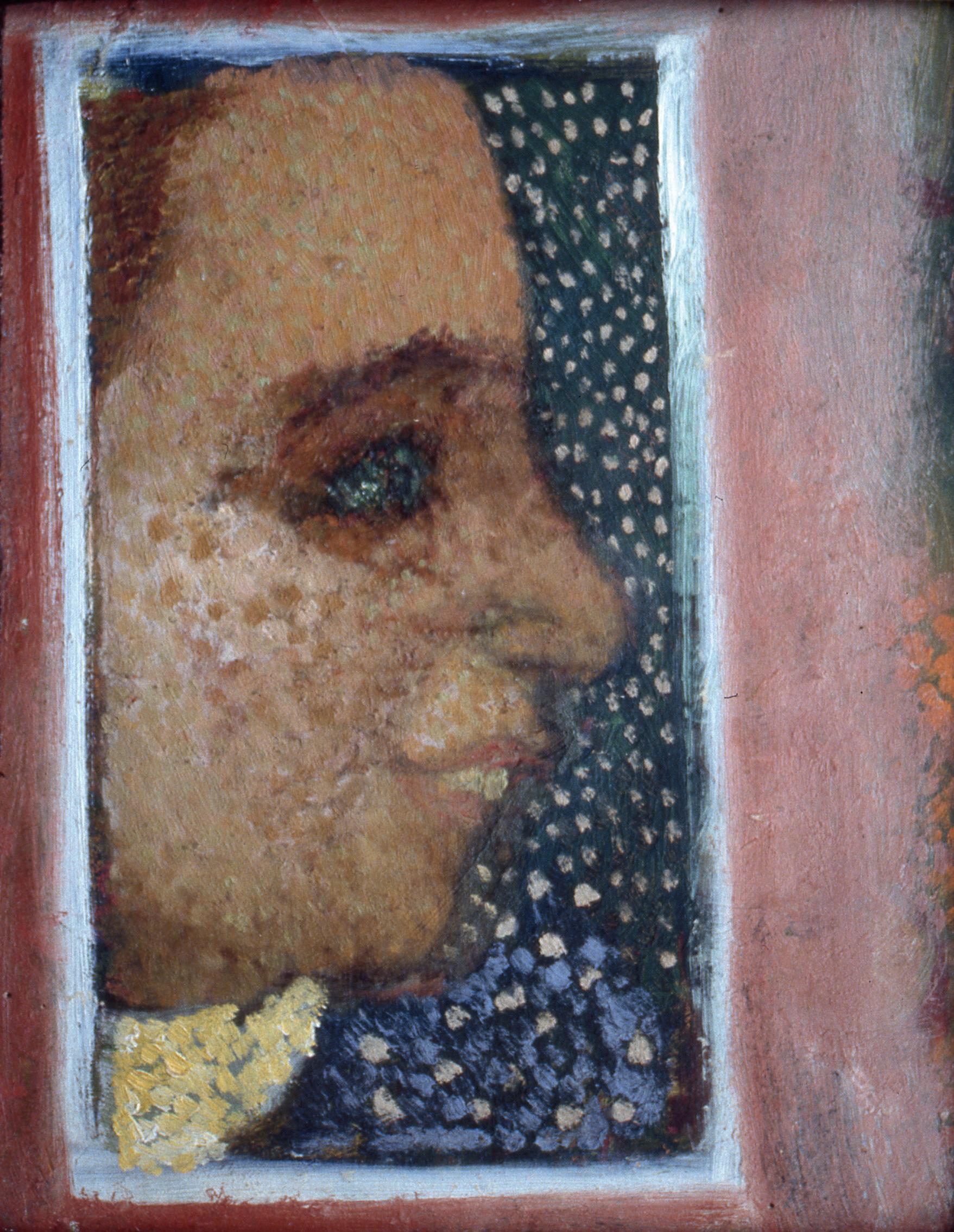
25
10 Femmes au ruisseau
Black pencil on wove paper, ca. 1894
Vertical monogram lower right MAVD
Sheet 135 x 64 mm
Provenance The artist’s studio, Saint-Germain-en-Laye; his son, Dominque
thence by descent, France a cohesive design, Denis adapts his composition to the needs of stained-glass, and in doing so finds formal harmonies between the women’s bodies and those of the animal and plant motifs. Denis proposed four projects, one of which was selected and produced in coloured glass using the Tiffany technique. The two other versions, one sketched and the other in gouache on cardboard (Musée Maurice Denis), suggest that this glass window project was carried out, but has unfortunately disappeared.
At the same time, some of Denis’ projects show his interest in the Arts & Crafts movement, which was initiated in England by William Morris to renovate the field of decorative arts. For the Nabis group, the impulse to decorate everyday objects was the ground for new experimentation. As Pierre Bonnard stated, “Our generation has always sought the relationship between art and life.”1 In 1894, the art dealer Siegfried Bing commissioned the Nabis group to design stained glass windows for his Maison de l’Art Nouveau, which opened in 1895. The present work, Femmes au ruisseau, is a preparatory drawing for this commission. Simplifying his forms and stylizing them according to
26
Denis, Saint-Germain-en-Laye;
1. Fabienne Stahl, Maurice Denis Bonheur Rêvé, Paris, 2021, p. 44.
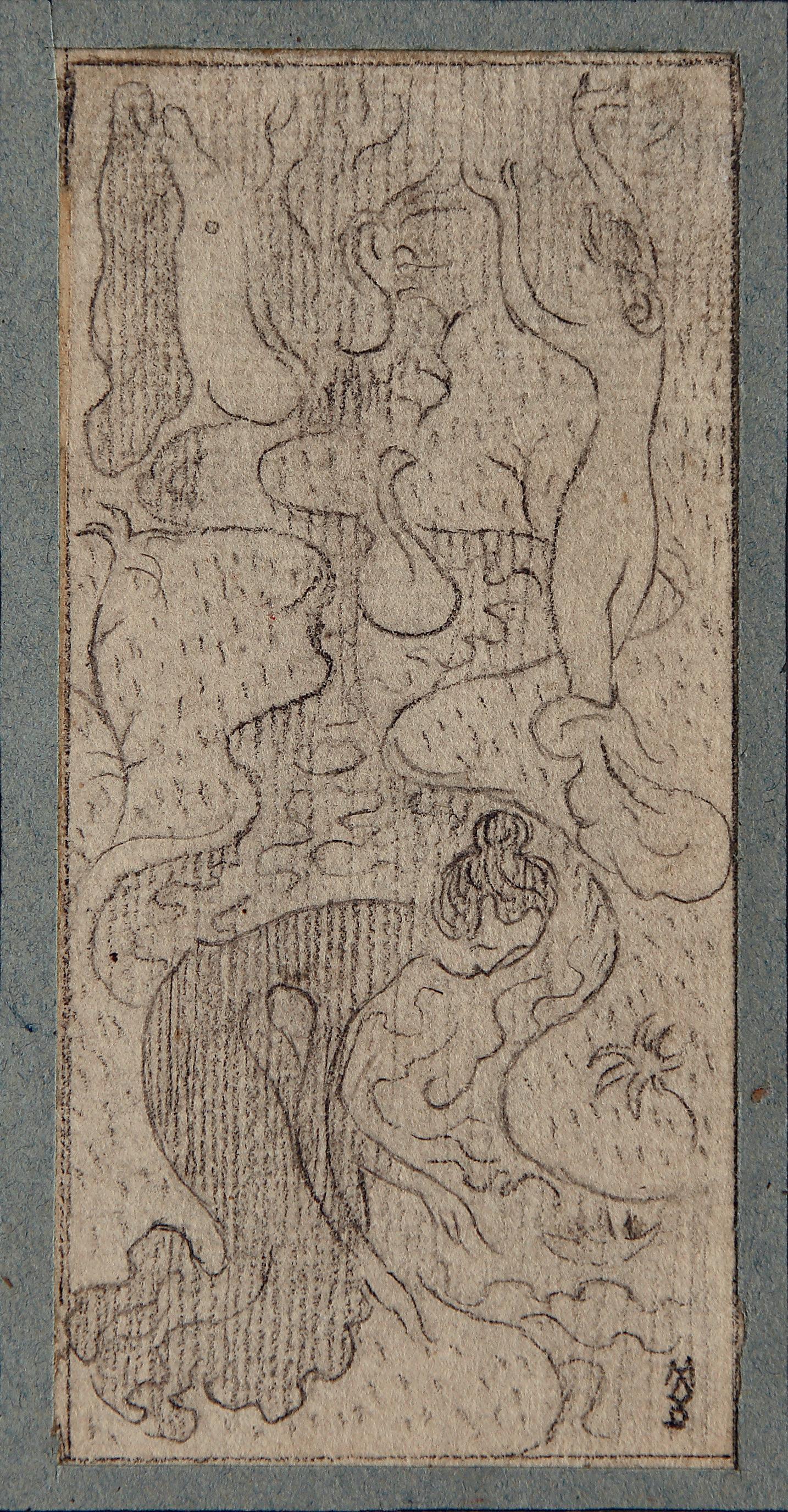
27
11 Marthe et Noële aux brebis
Gouache on wove paper, 1896
Vertical monogram, and dated lower left MAVD Nov 96 Sheet 175 x 730 mm
Exhibition Lyon, Musée des Beaux-Arts, Maurice Denis 1870-1943, 29 Sept.-18 Dec. 1994, no. 226, p. 328 (ill.)
Provenance The artist’s studio, Saint-Germain-en-Laye; his son, Dominque Denis, Saint-Germain-en-Laye; thence by descent, France with a bucolic landscape—a picturesque tone poem built of colour and form. Denis had already made a fan for Marthe’s twentieth birthday in 1891, and with this project he reversed the circle’s arc to form the shape of a lampshade, as he did in two other projects: Le Roi des aulnes (Erlkönig) of 1893, and Le Trottoir roulant, ca. 1900 (both at the Musée d’Orsay, Paris).
The Nabis’ interest in decoration continued for several years, and its artists often adorned every day, domestic objects with designs and subjects that related to Nature and the family. This is the case for Denis’ superb Marthe et Noële aux brebis lampshade drawing, for which the artist skilfully managed to combine an intimate portrait of his wife and their first daughter
28
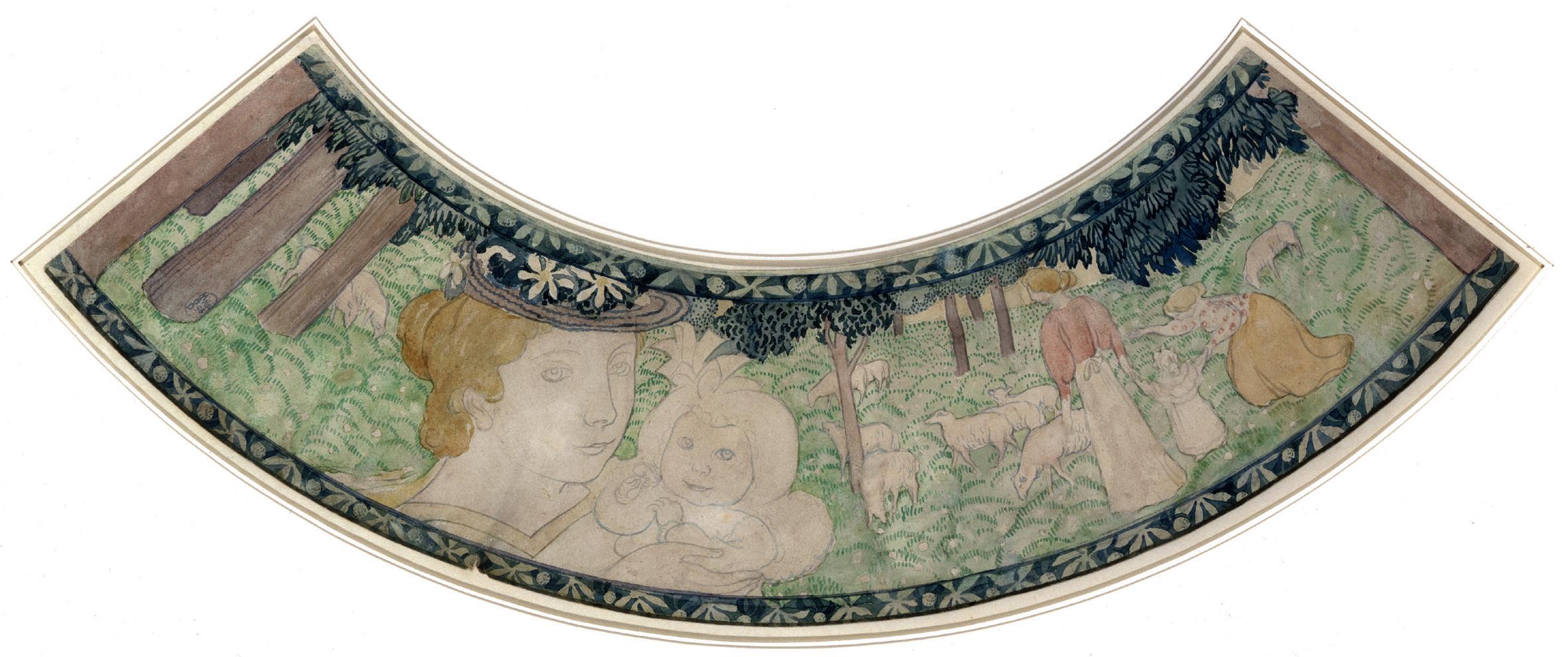
29
12 Douce vision
Black pencil on wove paper, ca. 1894
Inscribed up Douce vision, lower right PAR ANDRE ROSSIGNOL
Sheet 353 x 275 mm
Provenance The artist’s studio, Saint-Germain-en-Laye; his son, Dominque Denis, Saint-Germain-en-Laye; thence by descent, France lithograph Apparition of 1894 (Musée Maurice Denis, Saint-Germain-en-Laye), and it is similar to another composition, also entitled Douce vision, of 1896 (Private collection). The artist seems to have adopted the posture of this figure, who carries roses in her hands, for the Portrait d’Yvonne Lerolle en trois aspects of 1897 (Musée d’Orsay, Paris). In this latter work, the daughter of the painter Henry Lerolle is also shown standing, her body in three-quarter view and her face turned towards the viewer, holding roses close to her face. The roses on the ground, the flowering bush to her right, the two trees framing the composition, and the distant horizon of the landscape in the background also recall the present Douce vision
In parallel with these projects decorating domestic objects and architectural features, Maurice Denis also worked to illustrate literary publications. In 1894 he produced a series of lithographs for the covers of the booklet Apparition / poèmes de Stéphane Mallarmé / musique de André Rossignol. These illustrated musical plates, of which the present drawing, Douce vision, is a preparatory sketch, evoke a delicate melancholy and subtle grace. The women in these plates, with their languid silhouettes and their ample, flowing dresses, suggest a kind of fairy-tale feminine ideal, recalling the symbolic character of Denis’ work. This woman surrounded by rosebushes, perfectly sketched in pencil, could be a variant the woman found in Denis’
30
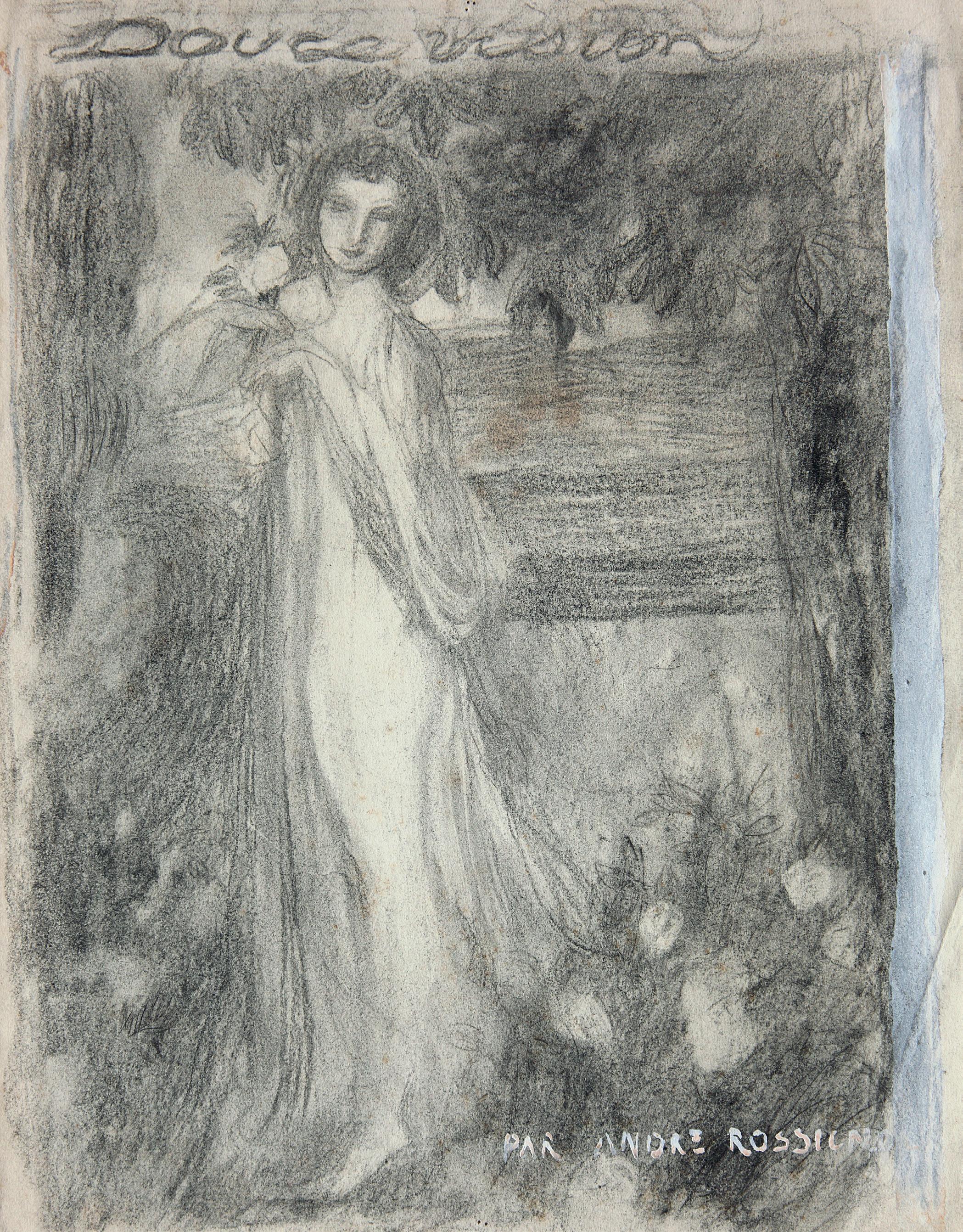
31
13 Portrait d’André Gide
Oil on cardboard, 1898
Vertical monogram lower right MAVD
Size 340 x 280 mm
Provenance The artist’s studio, Saint-Germain-en-Laye; his son, Dominque Denis, Saint-Germain-en-Laye; thence by descent, France another student, and it was through her that he entered the literary world and met André Gide. Seduced by Denis’ illustrations for Paul Verlaine’s Sagesse, Gide asked him in 1893 to illustrate his publication, Voyage d’Urien, for which the artist produced thirty lithographs. This portrait marks the deep friendship that united these two remarkable artists.
This extraordinary Portrait of André Gide similarly underscores Denis’ links with the literary world. This painting carries out Gauguin’s Synthetist principle of creating formal harmony through the play of tones. Here, the shadows, the costume, the moustache, and the beard of the writer are treated with shades of cool blue that contrast and complement the warm tones of his environment. During his studies at the Lycée Condorcet, Denis met Madame Finaly through Gabriel Trarieux,
32
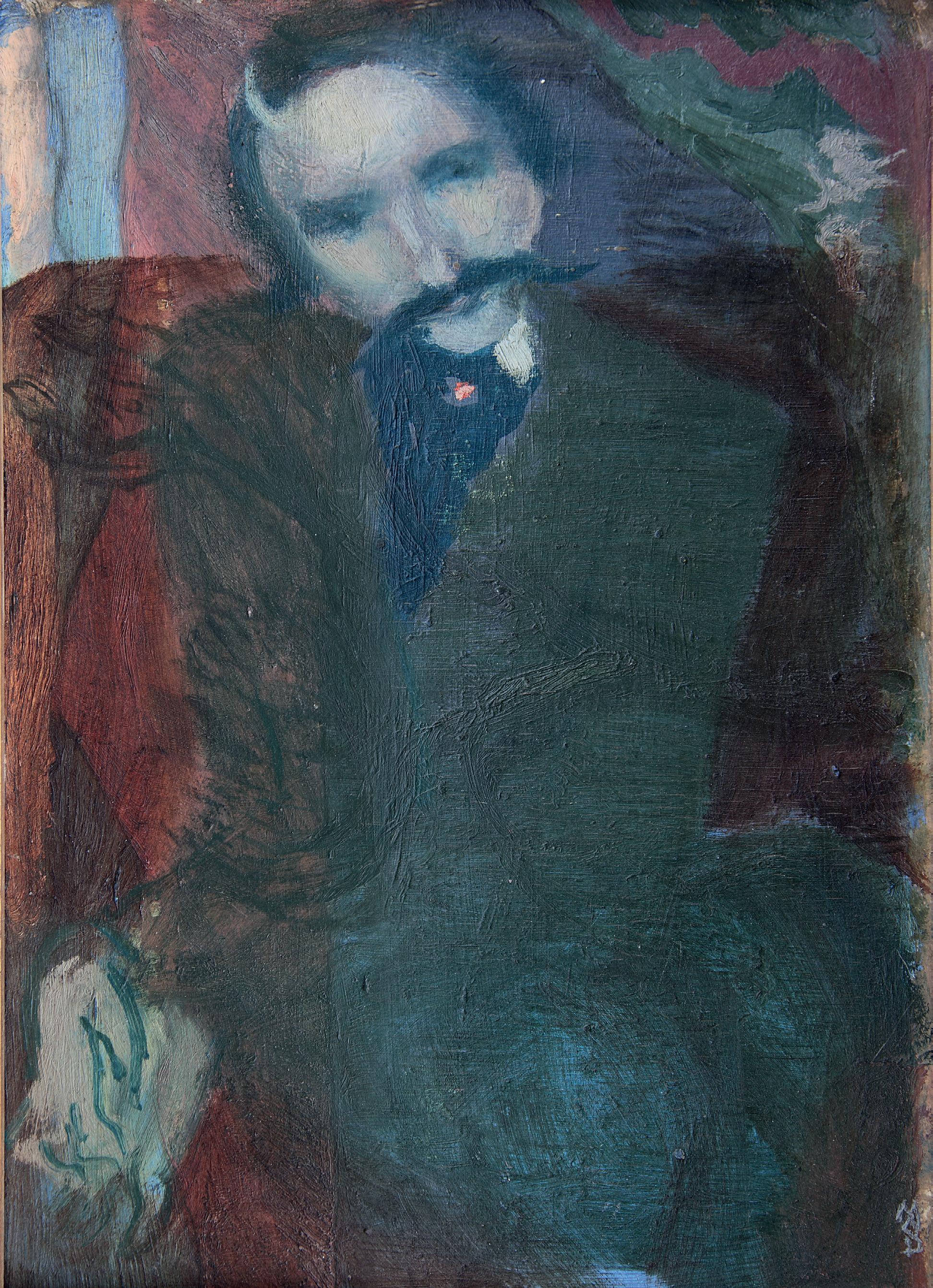
33
14 Autoportrait au chapeau noir
Charcoal on wove paper, 1897
Signed lower right M.D
Sheet 360 x 280 mm
Literature Jean-Paul Bouillon, Maurice Denis La Légende de saint Hubert 1896-1897, Paris, 1999, no. 60, p. 98 (ill.)
Exhibition Lyon, Musée des Beaux-Arts, Maurice Denis 1870-1943, 29 Sept.-18 Dec. 1994, no. 154, p. 302 (ill.)
Saint-Germain-en-Laye, Musée départemental Maurice Denis, Le Prieuré, 19 June- 17 Oct. 1999, no. 60, p. 98
Provenance The artist’s studio, Saint-Germain-en-Laye; his son, Dominque Denis, Saint-Germain-en-Laye; thence by descent, France
34
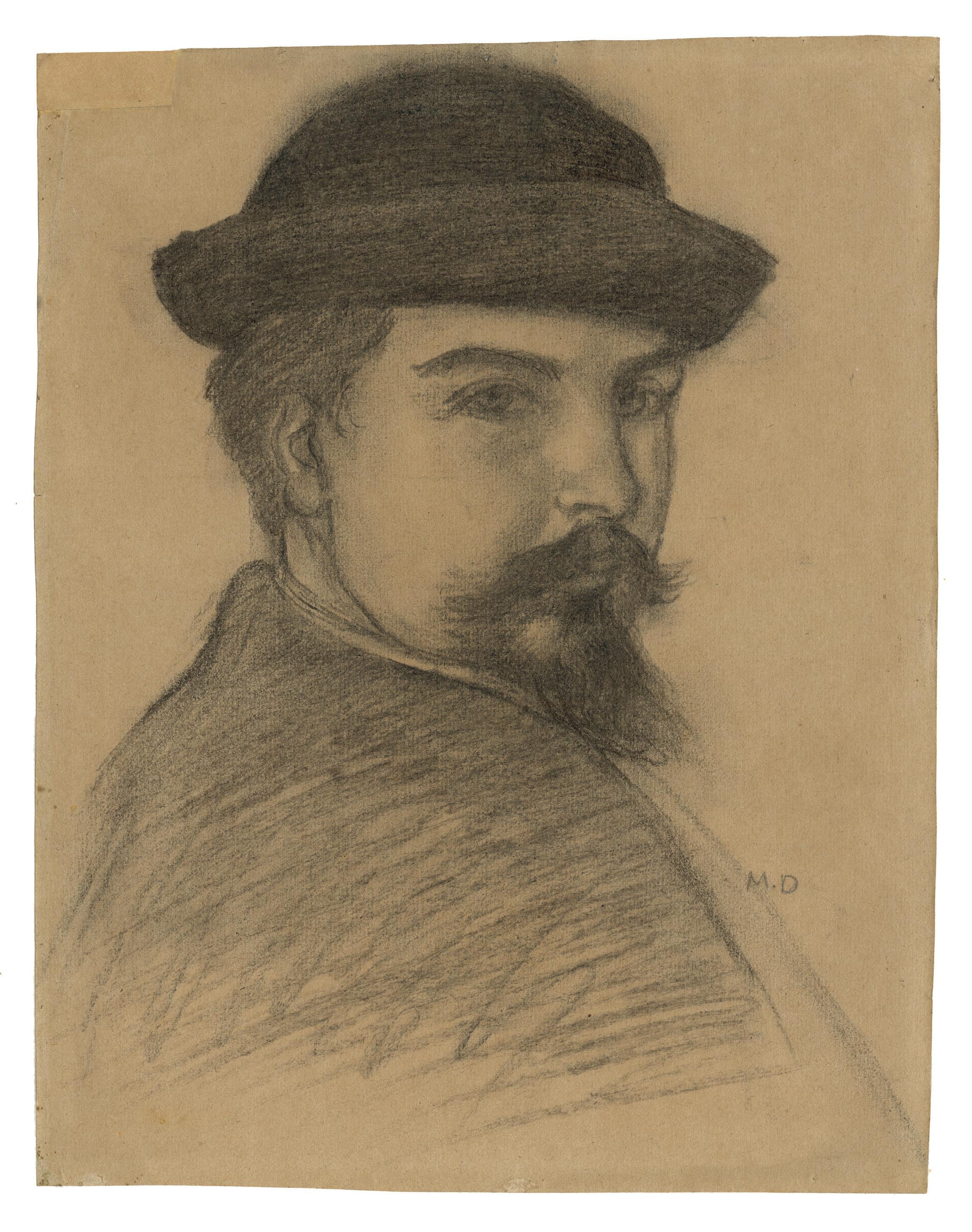
35
15 Autoportrait Étude pour le prophète Michée (verso)
Red chalk, charcoal and white chalk on wove paper, ca. 1900
Vertical monogram lower right MAVD on the front side, inscribed up MICHEE on the back Sheet 409 x 265 mm
Exhibition Lyon, Musée des Beaux-Arts, Maurice Denis 1870-1943, 29 Sept.-18 Dec. 1994, no. 158, p. 303 (ill.)
Provenance The artist’s studio, Saint-Germain-en-Laye; his son, Dominque Denis, Saint-Germain-en-Laye; thence by descent,
France
Like all great artists, Maurice Denis practised the art of self-portraiture. He made about fifteen self-portraits during his career, each of which bears witness to his state of mind, his artistic interests, and his physical appearance at a key period in his life. In October 1889 he wrote in his diary: “And in the mirrors, as I passed by, my face appeared less vulgar, as if radiating a higher spirituality.”1 This sense of confident self-regard is reflected in Autoportrait au chapeau noir, in which the artist looks directly towards the viewer under a straight round hat, his facial features precisely detailed. This drawing is a study for the fifth panel of the decorative ensemble La Légende de Saint-Hubert, commissioned in 1895 by Baron Cochin to decorate his office, and completed in 1897. The artist inserts his own likeness into the final composition. Denis again sought to integrate his personal and family life into a narrative of Christian iconography for the work Sinite Parvulos venire ad me of 1900 (Clemens Sels Museum, Neuss), for which the second Autoportrait is a study, this time
in red charcoal. On the reverse, Denis represented the prophet Micah for the decoration of the church of Sainte Marguerite in Le Vésinet. Denis wrote his preliminary notes that he took Odilon Redon as model for the portrait of this biblical figure.
This group of works suggests the creative and inventive genius of Maurice Denis, for whom art is naturally sacred. On March 24, 1895, the Nabi aux belles icônes – Denis’s nickname in the Nabi group – clarified the aesthetic conviction to which he remained faithful throughout his life: “Art remains the certain refuge, the hope of a reason in this life and the consoling thought that a little beauty is thus manifested in our life, that we continue the work of the creation, the harmonious law of universal life.”2
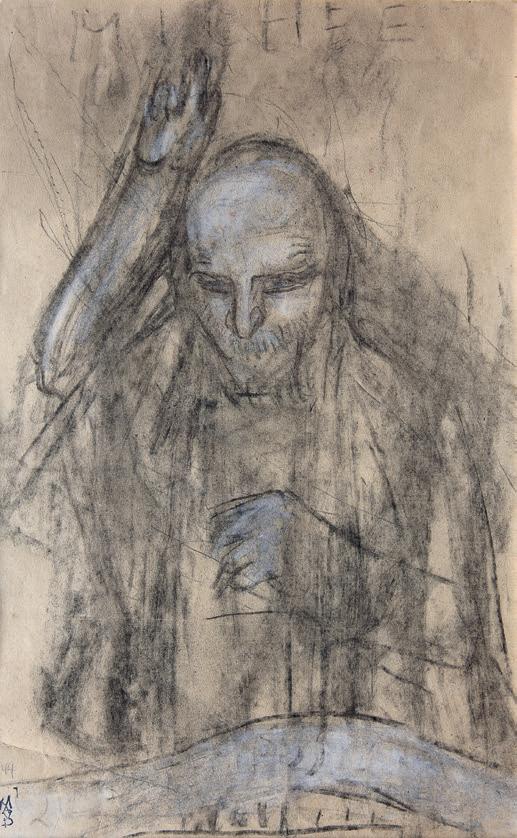
36
1. Fabienne Stahl, Maurice Denis Bonheur Rêvé, Paris, 2021, p. 38.
2. Maurice Denis, Journal , 24 mars 1895.
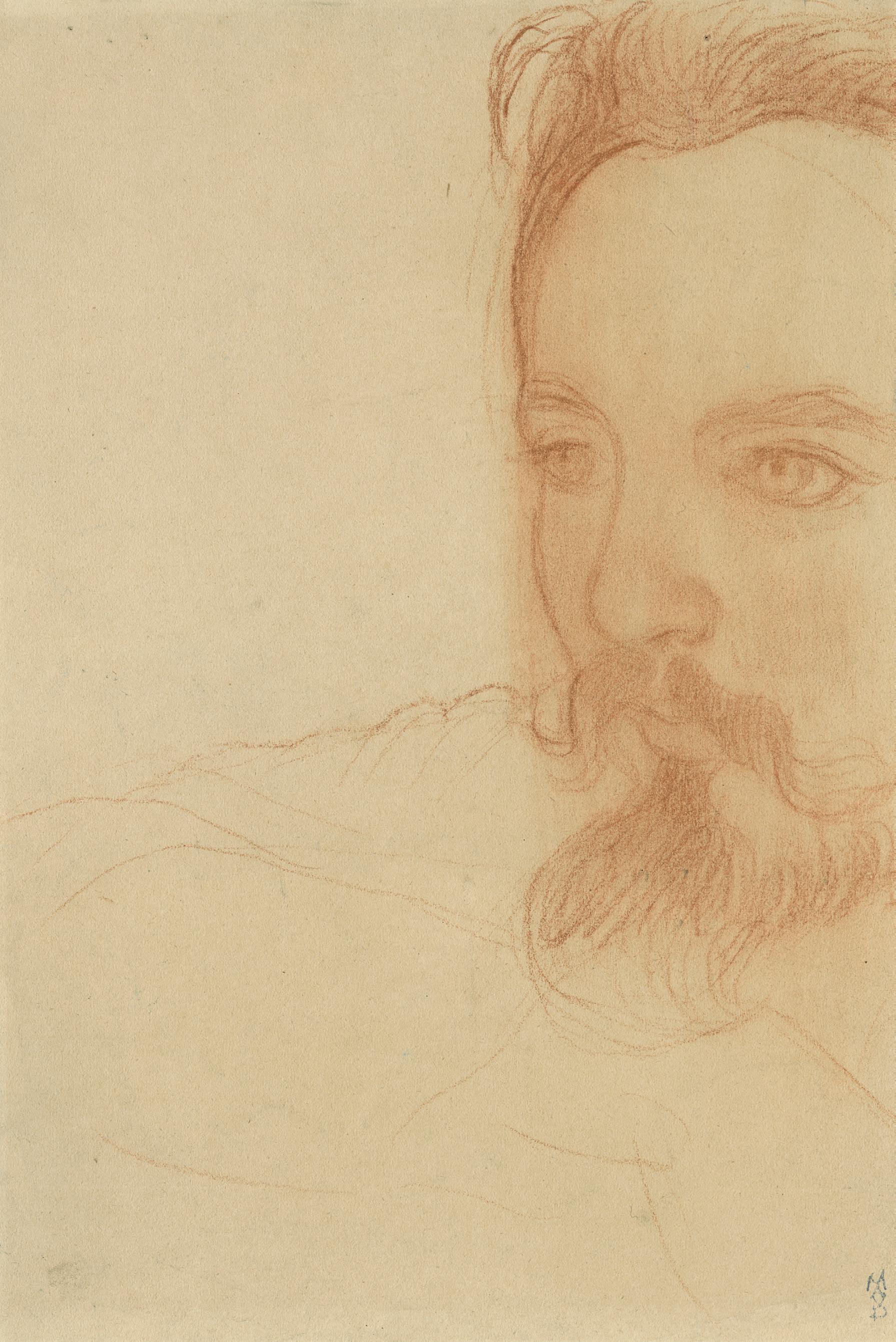
37
Index of works
Catalogue entries
Nicola Cataldo
Design
Tia Džamonja
Translation/Editing
Eric Gillis, Noémie Goldman, Rhonda Sherwood, Andrew Shea & Jean-Marie Gillis
Scan
Jérôme Allard – Numérisart
Special thanks to (by alphabetical order) to Melissa Hughes and her team, Dominique Lejeune, Valérie Quelen, Barbara Wawrzosek, and to all of those who have contributed to the publication of this catalogue.
© Agnews – September 2023
Eric Gillis
Autel jaune 8 Autoportrait 36 Autoportrait au chapeau noir 34 Douce vision 30 Enfant de chœur 20 Femmes à la Sainte Table 16 Femmes au ruisseau 26 Femme coiffant un enfant 22 Marthe et Noële aux brebis 28 Messe Matinale 18 Meule de paille 12 Nu aux cheveux noirs 6 Portrait d’André Gide 32 Portrait de femme de profil 24 Regard 10
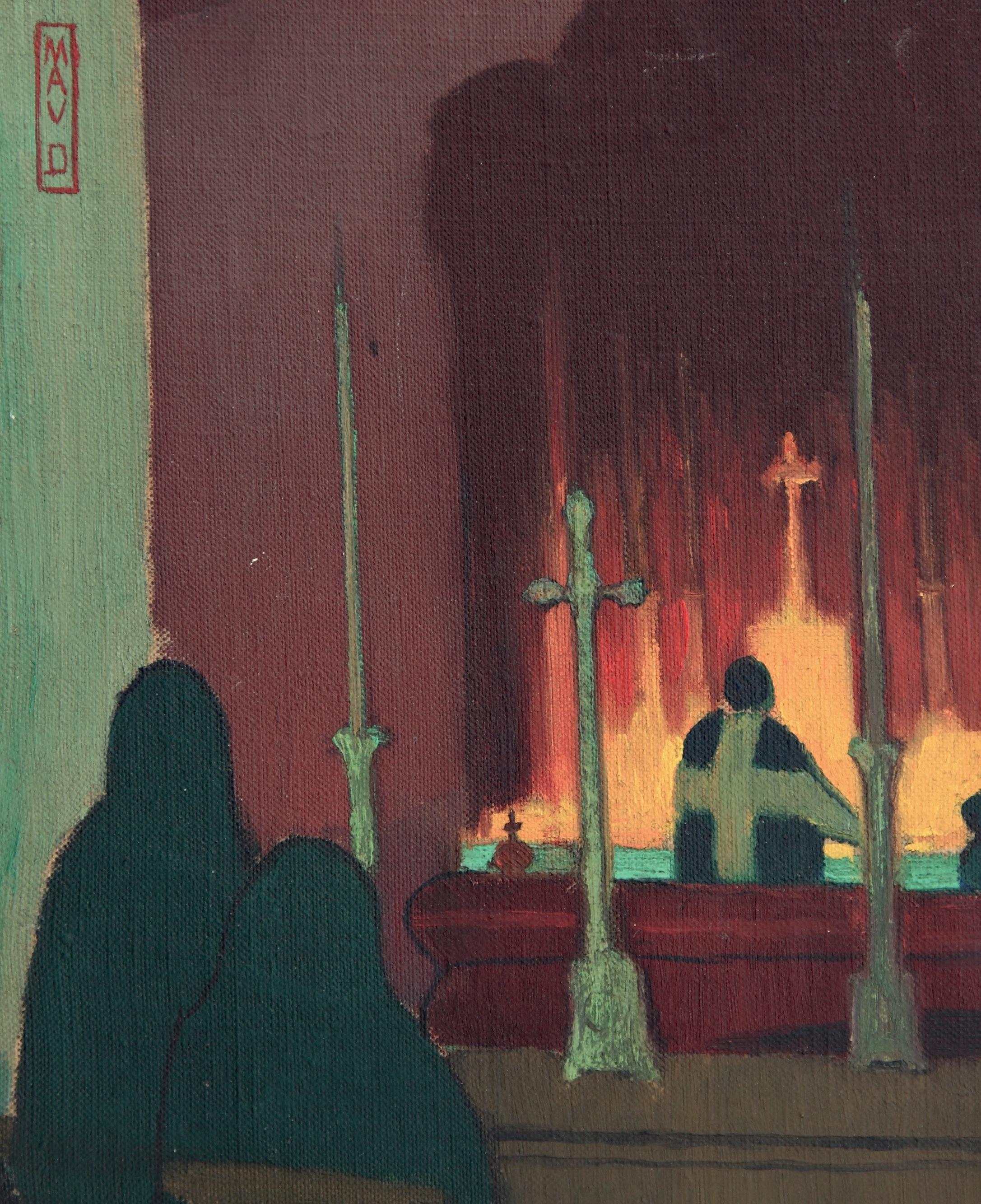
www.agnewsgallery.com London 6 St. James’s Place, London, SW1A 1NP anna@agnewsgallery.com Brussels 1 rue aux Laines, 1000 Brussels noemie@agnewsgallery.com





















